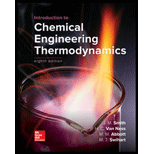
(a)
Interpretation:
The
Concept Introduction:
The value of
(a)
Answer to Problem 3.47P
The
Explanation of Solution
Given Information:
The virial equation is given as
For ammonia, the second and third virial coefficients are:
From given virial equation
Put the given values
On solving the equation
So,
(b)
Interpretation:
The
Concept Introduction:
In order to find value of
(b)
Answer to Problem 3.47P
The
Explanation of Solution
Given Information:
The virial equation in reduced conditions is given as
Here
For ammonia at given temperature and pressure, the critical conditions are given in table B.1 in Appendix B as,
For calculation of
And
So,
and
Hence, value of
And value of compressibility factor,
(c)
Interpretation:
The
Concept Introduction:
The Redlich/Kwong equations is an iterative procedure. So, we will use hit and trial procedure and guess some values of
According to Redlich/Kwong equations, the molar volume of ammoniacan be found using formula:
(c)
Answer to Problem 3.47P
From Redlich/Kwong equations, the molar volume of ammonia is:
Explanation of Solution
Given Information:
The Redlich/Kwong equation is
Here
From table 3.1 in the example based on Redlich/Kwong equation given in book, the values used to calculate the terms in equation (1) are:
For Redlich/Kwong:
And
So,
For ammonia, put values in equation (1)
Using hit and trial method and compare both side of equation, the calculated value from scientific calculator 991ES-PLUS or 991MS is:
Hence,
(d)
Interpretation:
The
Concept Introduction:
The Soave/Redlich/Kwong equations is an iterative procedure. So, we will use hit and trial procedure and guess some values of
According to Redlich/Kwong equations, the molar volume of ammonia can be found using formula:
(d)
Answer to Problem 3.47P
From Soave/Redlich/Kwong equations, the molar volume of ammonia is:
Explanation of Solution
Given Information:
The Soave/Redlich/Kwong equation is
Here
From table 3.1 in the example based on Soave/Redlich/Kwong equation given in book, the values used to calculate the terms in equation (1) are:
For Soave/Redlich/Kwong:
The values of reduced temperature and pressure are same as found in subpart (c), From reference subpart (c),
So,
For ammonia, put values in equation (1)
Using hit and trial method and compare both side of equation, the calculated value from scientific calculator 991ES-PLUS or 991MS is:
Hence,
(e)
Interpretation:
The
Concept Introduction:
The Peng/Robinson equation is an iterative procedure. So, we will use hit and trial procedure and guess some values of
According to Peng/Robinson equation, the molar volume of ammonia can be found using formula:
(e)
Answer to Problem 3.47P
From Soave/Redlich/Kwong equations, the molar volume of ammonia is:
Explanation of Solution
Given Information:
The Peng/Robinson equation is
Here
From table 3.1 in the example based on Peng/Robinson equation given in book, the values used to calculate the terms in equation (1) are:
For Peng/Robinson equation:
The values of reduced temperature and pressure are same as found in subpart (c), From reference subpart (c),
So,
For ammonia, put values in equation (1)
Using hit and trial method and compare both side of equation, the calculated value from scientific calculator 991ES-PLUS or 991MS is:
Hence,
Want to see more full solutions like this?
Chapter 3 Solutions
Loose Leaf For Introduction To Chemical Engineering Thermodynamics
 Introduction to Chemical Engineering Thermodynami...Chemical EngineeringISBN:9781259696527Author:J.M. Smith Termodinamica en ingenieria quimica, Hendrick C Van Ness, Michael Abbott, Mark SwihartPublisher:McGraw-Hill Education
Introduction to Chemical Engineering Thermodynami...Chemical EngineeringISBN:9781259696527Author:J.M. Smith Termodinamica en ingenieria quimica, Hendrick C Van Ness, Michael Abbott, Mark SwihartPublisher:McGraw-Hill Education Elementary Principles of Chemical Processes, Bind...Chemical EngineeringISBN:9781118431221Author:Richard M. Felder, Ronald W. Rousseau, Lisa G. BullardPublisher:WILEY
Elementary Principles of Chemical Processes, Bind...Chemical EngineeringISBN:9781118431221Author:Richard M. Felder, Ronald W. Rousseau, Lisa G. BullardPublisher:WILEY Elements of Chemical Reaction Engineering (5th Ed...Chemical EngineeringISBN:9780133887518Author:H. Scott FoglerPublisher:Prentice Hall
Elements of Chemical Reaction Engineering (5th Ed...Chemical EngineeringISBN:9780133887518Author:H. Scott FoglerPublisher:Prentice Hall
 Industrial Plastics: Theory and ApplicationsChemical EngineeringISBN:9781285061238Author:Lokensgard, ErikPublisher:Delmar Cengage Learning
Industrial Plastics: Theory and ApplicationsChemical EngineeringISBN:9781285061238Author:Lokensgard, ErikPublisher:Delmar Cengage Learning Unit Operations of Chemical EngineeringChemical EngineeringISBN:9780072848236Author:Warren McCabe, Julian C. Smith, Peter HarriottPublisher:McGraw-Hill Companies, The
Unit Operations of Chemical EngineeringChemical EngineeringISBN:9780072848236Author:Warren McCabe, Julian C. Smith, Peter HarriottPublisher:McGraw-Hill Companies, The





